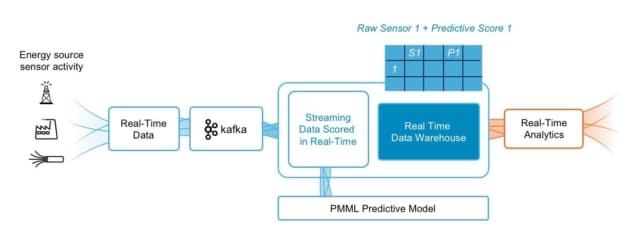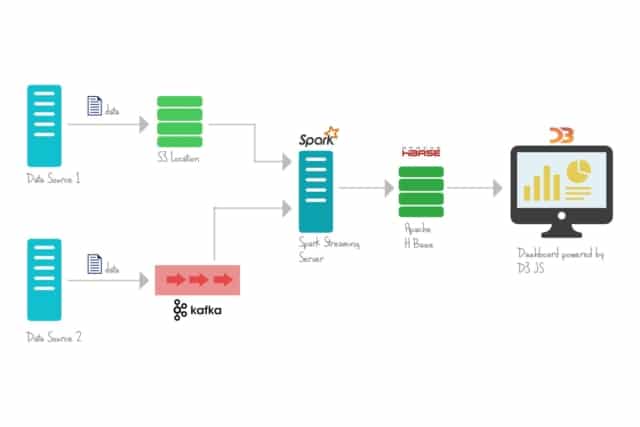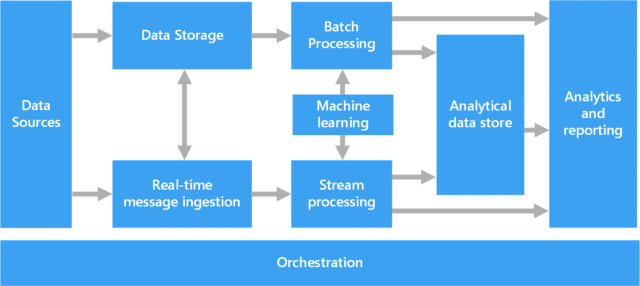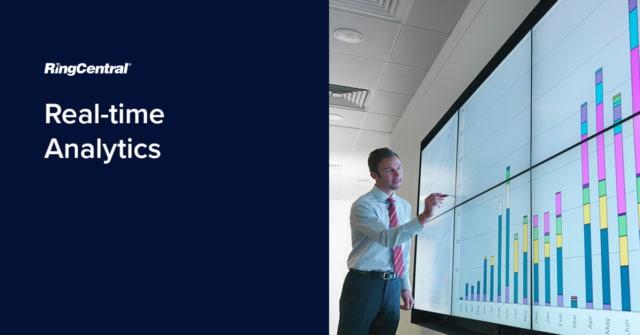Today, enterprises are dealing with a rapidly changing world. There is a lot of uncertainty. Organisations need to find technology solutions to keep up with the trends, but also to gain a competitive advantage.
Nothing is more important, then than making timely and effective decisions. Whether it’s sales, marketing, or IT, organisations need accurate information to make important decisions quickly. Time is money. And in competitive markets, making the right decisions rapidly gives a competitive advantage.
Enterprises are looking to cloud computing and data warehouse solutions for agility in a changing world. They are also seeking innovations to process and manage large amounts of data. A real-time analytics platform will speed up data handling and give deeper insights to an organisation.
What is real-time analytics?
Real-time analytics involves gathering live data for instantaneous analysis and prescribed action. Streaming data is gathered and analysed according to defined metrics. An enterprise will use an analytics platform to process data and gain insights. Data is measured, managed, and analysed as it enters the company database.
Accurate and rapid decision making helps an organisation benefit from these data-driven insights. These real-time insights can help to improve workflow within the business or to boost sales and marketing. They can also integrate with AI technology. Real-time big data analytics can provide for machine-led decision making over the internet of things (IoT).
How real-time analytics work

Real-time analytics operates at the edge of the network. That is, streaming data is managed and analysed as close to the source as possible to minimise latency. This means raw data is analysed before it gets to the data warehouse.
Tools can send or grab data as needed. This can be done continuously or at intervals. It depends on the nature of information and your business needs. Continuous streaming will be required for services that cannot experience any downtime.
End-user response times will vary according to several factors. Variables such as real-time analytics tools, IT architecture, and the data sets. Times can range from milliseconds to minutes or even hours. Financial traders may require continuous and instantaneous information. Whereas online sales may only need updates every five to ten minutes.
There are various solutions for implementing real-time analytics software. But all share four essential components.
Aggregator
The aggregator compiles real-time data streams from multiple and diverse data sources.
Broker
The broker manages the availability of the data and its consumption.
Analytics engine
The logic centre of real-time analytics is the engine. Here is where values are correlated, data streams blended, and data analysis takes place.
Stream processor
The processor executes the real-time application analytics by receiving and sending data streams.
Benefits of real-time analytics
The overall aim of real-time analytics is to increase the pace of all aspects of your business. A real-time analytics platform will gather and process big data and boast high availability (meaning data is always ready to crunch).
The end-user will perceive low latency when accessing analysis data, too. When the architecture is adequate, organisations will be quicker to make informed business decisions. And businesses will have faster reaction times to market changes or potential risks.
Visualisation

Visualisation of data creates a live depiction of what is occurring throughout an organisation. This allows decisions to be made with the most current information. Visualisation of real-time analysis via a dashboard offers details for businesses to react faster and avoid errors or other forms of risk.
Better marketing
Real-time insights on customer behaviour are gleaned. Information such as likes and dislikes allows for the opportunity to upsell consumers. These insights can also improve customer experience and retention. Businesses can also react to market trends instantaneously and improve marketing campaigns on the fly.
Stay competitive
Businesses using real-time analytics identify trends faster than competitors using historical data. Real-time data can also help organisations evaluate competitor performance to the second.
Money
Real-time analytics are a long-term investment. The upfront costs can be expensive, but the company performance and profits will increase long-term. Additionally, the time to produce is shortened and the IT burden reduced. And pricing for analytics platforms can be on-demand or pay-per-use to maximise value.
Speed
Instantaneous classification of raw data improves the efficiency of data centres. This increases overall IT performance. This can be coupled with technologies such as machine learning and AI. Together with streaming analytics, these technologies lead to effective trend predictions. The result is a prescriptive analysis and rapid decision making.
Examples of real-time analytics
Real-time analytics have diverse applications. Here are just a few use cases where data analysis improves business intelligence.

Credit scoring
Businesses are using real-time credit scoring to increase sales and reduce risk. Instant credit scoring allows consumers to finance and make purchases without a waiting period.
Such a waiting period can result in the loss of the sale. But also, since businesses have access to the most accurate information, credit approval comes with a lower risk. In this case, both the consumer and the business benefit from real-time analytics.
Transportation logistics
Delivery trucks and trailers are outfitted with sensors and GPS to track routes. Data like fuel efficiency, speed, and timeliness are compiled and analysed in real-time. This information helps to reduce fuel costs and ensure deliveries are on time.
The real-time route planning also helps drivers to avoid dangerous route conditions and closures. And of course, customers are happy when their deliveries arrive without delay.
Financial trading
When it comes to buying and selling on the open market, financial firms need access to the most up-to-date information. Complex, financial databases can be analysed in real-time. These streaming analytics support improved risk computations for banking institutions. In some instances, decisions have to be made in seconds or milliseconds.
Real-time big data analytics minimises risk and provides instantaneous decision making. Institutions can use diverse data to make informed decisions. This includes data sets from weather stations and social media. Rapid portfolio decisions enable organisations to stay competitive in a rapidly changing industry.
Healthcare

Real-time analytics is having many positive effects on healthcare. One example is through the use of wearable devices. Devices such as a smartwatch or a smartphone. These tools aid physicians and healthcare workers in saving lives.
They do this by monitoring vital health statistics like heart rate in real-time. The analytics produced give doctors new insights into an individual’s health. These insights will take healthcare to the next level of care and customisation.
What are the challenges in real-time analytics?
While real-time analytics and data processing offers many solutions and great benefits, it also presents several challenges. Because of its complexity in design and utilisation, organisations should be aware of the issues.
Architecture

There are a few IT requirements for real-time analytics to work. First, the data architecture must be capable of processing data at a high speed. This can be especially difficult. The data and its source can vary, and even change in real-time. And to avoid service disruptions, the streaming analytics must be able to handle any data spikes.
Additionally, data must be highly available with low response times. The response time for applications and users to pull the analytics must be low and consistent. Changes will happen in real-time. These changes complicate the necessary design of the analytics architecture.
The definition of real-time
For every organisation, “real-time” can mean several different things. Is it instantaneous or up to date in minutes? “Real-time”, then, must be defined by the stakeholders in an enterprise. Only after this can the organisation begin any analytics implementation.
This ensures the entire organisation is on the same page and the correct architecture is in place. Businesses must decide what real-time means for them and their products or services. Businesses must also understand their technology needs for investing and implementing real-time analytics.
Absence of specialists
Real-time analytics is a relatively new and evolving field. It can be difficult for organisations to find highly specialised and experienced individuals with the right know-how. This creates difficulty with management, creation, and implementation within the business.
These issues can make adoption a slow and painful process. Enterprises may prefer to look within their own IT departments and allow them the necessary time to plan and get things right.
Future of real-time analytics
Analytics is one of the best tools organisations have to gain consumer and market insights. Big data is projected to bring in a revenue of 274 billion dollars in 2022. The adoption of cloud computing, AI, and machine learning will continue to change the way businesses operate and analyse data.
In the business world, analytics has evolved. Progression is required to stay competitive in the modern world. From descriptive analyses based on what has happened in the past, to predictive analytics for what will happen in the future.
But now, organisations are adopting technologies to implement prescriptive analyses. Predicting not only what will happen, but also how it can happen better. It depends on organisations to follow the information and change the correct variables.
Technology for real-time analytics will continue to evolve. More industries will normalise adoption in the future. Higher education and pharma are beginning to look at real-time analytics. These industries are particularly interested in the consumer insight benefits of real-time analytics.
How RingCentral supports real-time analytics for business

In 2021, more organisations will seek to adopt technologies for digital transformation. The past year taught companies that many aspects of business can be run outside of the office.
More organisations are now looking for the flexibility to work from anywhere and at any time. Enterprises are moving to cloud or remote contact centres and other processes, and gaining many benefits. Remote work can reduce overhead costs and offer greater work flexibility to increase productivity.
RingCentral provides real-time reporting and analytics for your call centre and team. Fully customisable dashboards can provide the information you need. Managers will have access to overall performance for all areas at any time they need it. Real-time visualisations will allow for a better focus on agent performance and management.
But even better, our real-time analytics will give you deeper insights into customer behaviour. Live data provided on queues and interactions can help managers and supervisors build a better customer experience.
Advanced analytics tools like sentiment analysis can tip off supervisors early that a call isn’t going well and may need to be escalated.
Team up with RingCentral today and give your business the flexibility it needs for the future. And gain the benefits of our real-time analytics to improve your company workflow and customer experience!
Originally published Apr 14, 2021, updated May 15, 2021

